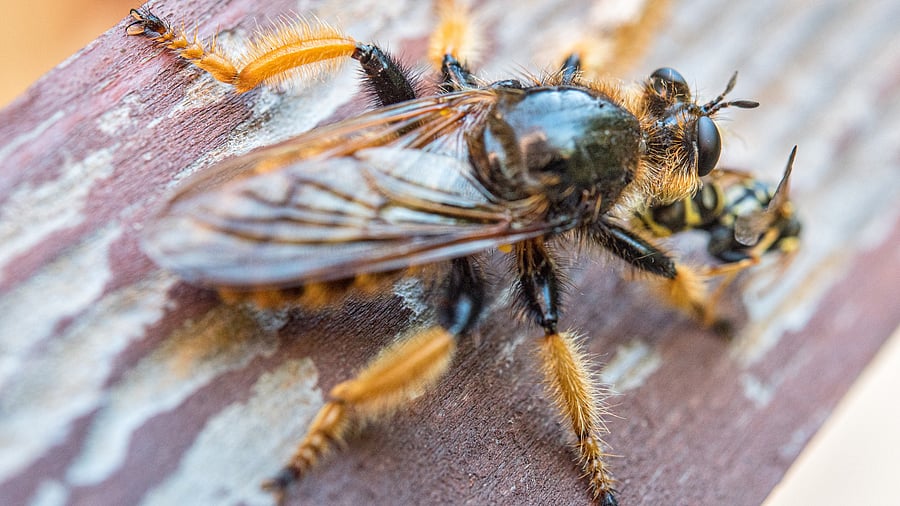
Representative image showing hornet eating a wasp.
Credit" iStock Photo
By Lara Williams
Last month, something ominous was spotted in Ash, a quaint, peaceful village in south east England— an Asian hornet, also known as the yellow-legged hornet. These predatory insects, with a voracious appetite for honeybees, are indigenous to southeast Asia. Elsewhere, they’re categorized as an invasive alien species.
The Asian hornet is just one of several non-native species— meaning an animal or plant introduced through human activity with the ability to spread and cause damage to the environment, economy or human health— that could have huge economic consequences. While trade and travel get them through the door, climate change could make things much, much worse in the years ahead.
The UK specimen was spotted a full month sooner than the previous earliest annual sighting, prompting some experts to theorize that a hornet seen so early is evidence of overwintering in Britain. Helen Roy, an ecologist at the UK Centre for Ecology and Hydrology, told me it’s too early to say for sure. Given that France, Belgium and the Channel Islands now have sizable hornet populations, there’s still a chance it could have been a hitchhiker. We’ll find out the truth as the year progresses.
The insects, distinguishable by their yellow-tipped legs and dark abdomens, pose a serious danger to our native pollinators. Just one Vespa velutina can eat as many as 50 honeybees a day, catching them as they enter or leave their hives, and their mere presence can make bee colonies less likely to forage and scare other fertilizing bugs away from flowers.
Their potential impact on biodiversity, food production and the economy is worrying. Research in France, where the hornet was first accidentally introduced after it caught a lift alongside some pottery from China, suggests that the annual economic damage could reach €30.8 million ($33.2 million) due to bee colony loss. For beekeepers, that equates to spending more than a quarter of honey revenue on replacing lost bees.
And the risks extend beyond just bees. Hornets also like to feed on ripe fruit, posing a threat to wine growers. And with wild pollinators already in decline thanks to habitat loss and pesticide use, a new threat could be existential. Best believe we’ll feel the impact in crop yields.
Asian hornets do just fine in our current climate, but as places get hotter, the potential for new aliens to establish themselves opens up.
Red imported fire ants, for instance, already rank among the worst invasive species in the world. Native to tropical areas in central South America, these ants and their relatives have already invaded the US and Australia, costing an estimated $32 billion globally. They pose threats to native biodiversity, reduce yields for farmers and cause structural damage to buildings. In September, their presence in Europe was confirmed for the first time, with researchers discovering 88 nests in Sicily. Currently, only 7 per cent of the continent is climactically hospitable to them, including half of all urban areas— but climate change significantly increases their potential habitats.
Existing threats could also get worse: Japanese knotweed, the bane of gardeners and landowners across Europe and North America, has emerged six weeks earlier than usual this year thanks to mild weather. There’s a population of about 4,000 feral red-eared terrapins in the UK, released into the wild by owners who bought them when Teenage Mutant Ninja Turtles were all the rage, but couldn’t deal with their full size. These amphibians eat everything from newts to frogspawn. Living for as many as 30 years, terrapins currently can’t breed in Britain; but the more we see sustained heat over the summer months, the more likely it is that they’ll start reproducing.
The UK’s handling of the Asian hornet threat is widely viewed as a success. Though we benefit from being an island and have learned from France’s experience battling the insect, forward planning— the UK had a response outlined five years before the first arrival— has stopped the invasive population from becoming endemic, even as sightings increase.
Long-term planning for invasive alien species should be a priority for policymakers and investors alike. The most cost-effective solutions involve stopping the intruders from arriving in the first place; but once they’re in the country, monitoring and eradication efforts are vital.
At the moment, detection relies on the public and stakeholders— beekeepers, farmers— reporting suspected sightings, but advances in artificial intelligence could aid efforts. Scientists at the University of Exeter are currently testing an AI monitoring station on Jersey. The software, called VespAI, can detect hornets with 99 per cent accuracy. Use of deep-learning technology could also prove effective in tracking down invasive weeds, fish and predators.
We’ll need every tool at our disposal. Invasive species cost the global economy more than $423 billion in 2019, according to a report by the Intergovernmental Platform on Biodiversity and Ecosystem Services, with costs at least quadrupling every decade since 1970. If we ignore these dangers until something lands on our doorstep, it’ll already be too late.